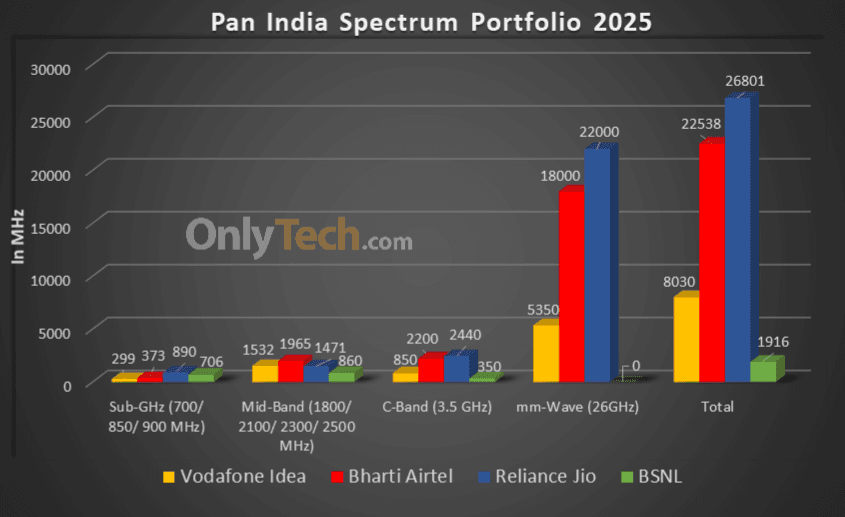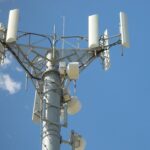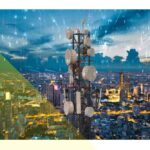Spectrum is for telecommunication what jet fuel is for aviation. Spectrum is a range of electromagnetic frequencies or airwaves that telecom companies use for establishing a connection between a cell tower and a mobile phone. The bandwidth of this spectrum is directly proportional to the speed of a wireless data network (since more data can be transmitted simultaneously through a broader data pipeline). In contrast, the frequency is inversely proportional to the coverage (since lower frequencies penetrate better through physical barriers and thus have wider coverage).
The spectrum holding data sheet embedded in this article represents the current spectrum holdings of all active telecom operators across all frequency bands across all 22 telecom circles along with their liberalisation status and expiry dates. All figures represented are in MHz. The value mentioned in the bracket beside the frequency at the base of each sheet is the band number where ‘B’ stands for 4G LTE band whereas ‘n’ stands for the corresponding 5G NR band.
The spectrum shown under BSNL and Aircel in white is reserved for the respective operators but has not yet been officially allotted to them.
Spectrum Liberalisation:
Spectrum was administratively allocated to operators in each of the 22 licensed service areas or circles prior to 2010, this spectrum is called non-liberalised and can only be used for 2G services whereas all airwaves allotted post-2010 have been through a Spectrum Auction where operators have paid the market discovered price and this spectrum is called liberalised and can be used for any technology platform 2G/3G/4G/5G. Alternatively, operators may choose to liberalise their administratively allotted spectrum by paying the market-discovered price to DoT on a pro-rata basis for the remaining validity of the spectrum.
Paired and Unpaired spectrum:
Spectrum may be paired or unpaired, bands 1/3/5/8/28 are all paired where one set of frequencies is used for uplink whereas another distinct set of frequencies is used for downlink known as Frequency-division duplexing (FDD), whereas bands 40/41/78/258 are unpaired where both uplink and downlink happens in the same set of frequencies separated by the time of uplink and downlink known as Time-division duplexing (TDD).
List of Indian FDD Bands:
| 4G LTE band | 5G NR band | Uplink frequency range (MHz) | Downlink frequency range (MHz) | Bandwidth for telecom (MHz) | Block size (MHz) |
|---|---|---|---|---|---|
| B1 | n1 | 1939-1979 | 2129-2169 | 40×2 | 5×2 |
| B3 | n3 | 1710-1780 | 1805-1875 | 70×2 | 0.2×2 |
| B5 | n5 | 824-844 | 869-889 | 20×2 | 1.25×2 |
| B8 | n8 | 890-915 | 935-960 | 25×2 | 0.2×2 |
| B28 | n28 | 723-733/ 738-748 | 778-788/ 793-803 | 20×2 | 5×2 |
List of Indian TDD Bands:
| 4G LTE band | 5G NR band | Frequency range (MHz) | Bandwidth for telecom (MHz) | Block size (MHz) |
|---|---|---|---|---|
| B40 | n40 | 2300-2380 | 80 | 10 |
| B41 | n41 | 2535-2555/ 2615-2655 | 60 | 10 |
| – | n78 | 3300-3670 | 370 | 10 |
| – | n258 | 24250-27500 | 3250 | 50 |
Spectrum caps:
A spectrum cap dictates how much spectrum a particular operator can hold in a circle for a specific band. There is a 40% cap for Sub-GHz spectrum in the 700/850/900 MHz bands combined, a 40% cap for Mid-Band spectrum in the 1800/2100/2300/2500 MHz bands combined, a 40% cap for the C-Band spectrum of 3300-3670 MHz and a 40% cap for the mm-Wave spectrum bands of 24.25-27.5 GHz. The current spectrum caps are denoted in the spectrum chart.
Overall spectrum holdings of operators (in MHz):
| Operator/Holding | Jio | Airtel | Vi | BSNL |
|---|---|---|---|---|
| Sub-GHz | 890 | 373.2 | 298.8 | 706 |
| Mid Band | 1470.8 | 1964.9 | 1531.6 | 860 |
| C-Band | 2440 | 2200 | 850 | 350 |
| mm-Wave Band | 22000 | 18000 | 5350 | 0 |
| Total | 26,800.8 | 22,538.1 | 8,030.4 | 1,916 |
Spectrum sharing/trading/leasing guidelines:
- Telecom operators holding CMTS/UASL/UL licenses can enter into a Spectrum-Sharing agreement with each other so long as both parties hold liberalised spectrum in the same band in the same circle. Spectrum sharing is possible only on a Pan LSA level in block sizes defined by DoT and only after one year of an operator acquiring the spectrum.
- Telecom operators holding CMTS/UASL/UL licenses can enter into a Spectrum-Trading agreement with each other so long as the spectrum being sold is liberalised. Trading of spectrum is possible only on a Pan LSA level in block sizes defined by DoT and only after two years of an operator acquiring the spectrum.
- Telecom operators may enter into a Spectrum-Leasing agreement only with Enterprises holding a Captive Non-Public Network (CNPN) license and not with each other. The lease may be limited to any geographic area within the LSA and for any duration mutually agreed upon by both parties. A CNPN licensee can lease spectrum from multiple operators within an LSA.
Note: We update this chart in real-time to ensure it is always up to date with the latest changes in spectrum holding. Certain human errors might have crept in during the manual compilation of the data, any mistakes/ rectification can be brought to the Team’s notice through the comments section below.








When will Mumbai – Maharashtra ; Kolkata – West Bengal be merged like Chennai – Tamilnadu RLH circles?.
RLH means Roam Like Home
If you mean the circles being merged physically such that an operator can bid for spectrum for the entire region in one chunk then that’s never going to happen since the revenue generating capacity of Mumbai will always be higher than rest of Maharashtra and that of Kolkata more than rest of West Bengal. With Chennai and rest of Tamilnadu that distinction was not so prominent so they were merged.
If you are referring to the functional merger where you don’t get charged higher while roaming for receiving and making outgoing calls while outside your home circle, then in that case in the present situation, entire India is roam like home. You can permanently be using any circles sim in any other circle without having to worry about roaming charges, though it’s advisable to port to the circle where you will be staying.
No. Still roaming charges will apply (incoming Rs.0.45 for using BSNL SIM in vodafone Mumbai or Delhi ; Rs.0.80, Rs.1.15 for calls and Rs.0.25 and 0.38 for SMS) which is cheaper than home circle (Rs.0.025 per minute).
When chargeable STVs (Rs.0.10, Rs.0.30, Rs.0.35, Rs.0.45 per minute etc) were there I can use TN STVs of airtel only in TN and Chennai after May 2005. Those chargeable STV benefits were not working during national roaming. This is what I criticized that paid STVs didn’t work during national roaming.
Can you answer my previous post above?.
Just use Jio with any unlimited bundled plan and you won’t face this issue anywhere in India. Why to complicate things?
That’s because Sudhakar always loves complicating things. xD
So you are saying that if I use TN Jio number and use it in the Mumbai circle to call a number (mobile OR LL) in Maharashtra it will be showed as a STD call in the itemized statement in the Jio app (even if the call was free or chargeable). Right?.
It will probably be shown as STD and you won’t be charged for it.
Hello Esmail,
I am not able to use 3G or 4G internet in Maharashtra since last year, since Airtel removed their 3G from the 900/2100 frequency and started 4G on these frequencies.
My phone is Motorola 3rdGen Dual Sim XT 1543 and it does have 4G bands 4, 7 and 28 capability along with 3G freq: 850/900/1700/1900/2100.
It works perfectly fine in US and Canada due to Band 4(AWS maybe), and in UK due to Band 7, Australia due to Band .
But no luck with Airtel now in India.
Would you please advice if VIL will provide at least 3G connectivity on my phone in India, esp. Maharashtra?
Anything that the new Spectrum auctions could benefit me this year or next, so that I do not have to change my phone?
Regards,
Kumar
The auction won’t help you since the 4G bands that your phone supports won’t be used by Indian operators. Yes as for 3G you will get Idea 3G in Maharashtra as of now until they switch off 3G like Airtel did. Then your only option will be BSNL. Or you could change your phone to one that supports Indian bands.
Vodafone has also started shutting down its 3G. Also the future of this company’s existance is a big question mark now. The only option for you is BSNL.